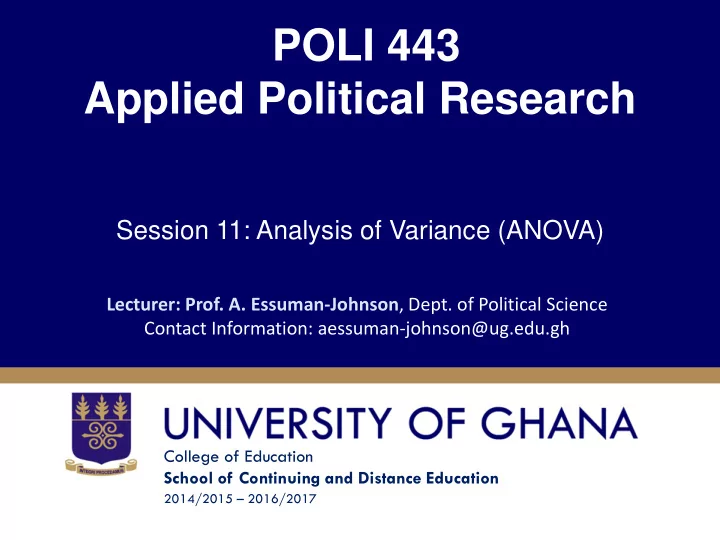

POLI 443 Applied Political Research Session 11: Analysis of Variance (ANOVA) Lecturer: Prof. A. Essuman-Johnson , Dept. of Political Science Contact Information: aessuman-johnson@ug.edu.gh College of Education School of Continuing and Distance Education 2014/2015 – 2016/2017
Analysis of Variance (ANOVA) • Introduction • The analysis of variance (ANOVA) method helps the researcher’s hypothesis that the dependent variable (which is at interval or ratio level) is related to the independent variable. This section will take you through the methods for the computation of the analysis involving the variance. The analysis of variance involves comparing the variance in each of the groups with the total variance in the dependent Slide 2
• variable to see how much of the total variance has been explained by the independent variable. The first step in the difference of means test and the analysis of variance is to compute the mean and variance for the cases created on the dependent variable. This variance is called the total variance (the question will normally specify the total variance for the data). The cases are then divided into two or more groups based on the independent variable and the mean and variance for each group are computed. Slide 3
• If the means of the groups are different and the possibility that this could be due to chance can be eliminated, then a relationship between the two variables is indicated by the means test. We can get an idea of the direction and strength of the relationship revealed by the computations by taking note of which group(s) has the higher mean and by comparing the variances of the analysis group with the total variance for all the observations. Slide 4
• A more precise measure of the relationship is given by an analysis of variance and a correlation called eta-squared (E 2 ). E 2 represents the amount of reduction that has occurred in the total variance due to the division of the cases into groups based on the independent variance. To compute E 2 we take the total variance, subtract from it a weighted sum of the variances left in the analysis groups (called the unexplained variance) and divide this by the total variance. Slide 5
• The numerator of this ratio is the explained variance and the higher the number the stronger the relationship. • E 2 = Total SS – Unexplained SS/Total SS • = Explained SS/Total SS • Where SS = Sum of squares Slide 6
• In the Gender-Amount Contributed example in the previous session (difference of means test), the total variance given was 26.8 The unexplained variance left after the cases were disaggregated (divided) into males/females is the average of the two variances left (14 and 7.6 weighted by the number of cases in each group) as follows: • [5(14) + 5(7.6)]/10 = (70 + 38)/10 = 108/10 = 10.8 Slide 7
• Substituting the values • E 2 = Total SS – Unexplained SS/Total SS = Explained SS/Total SS • = 26.8 – 10.8/26.8 = 16.0/26.8 = 0.6 • This value of eta – squared (E 2 ) means that 60% of the variance in the independent variable has been explained by the independent variable and it indicates a fairly strong relationship between Gender and the amount of contributions made to election campaigns. Slide 8
Assignment • In the assignment above work out E 2 and interpret what the answer mean (Hint: You have to use the recalculated variance for the female contributions for your computations. • In the example above add GH¢5,000 to the contribution of each female contributor and do the analysis again. (Hint: You have to rework the mean and variance for the female contributions). Slide 9
Recommend
More recommend